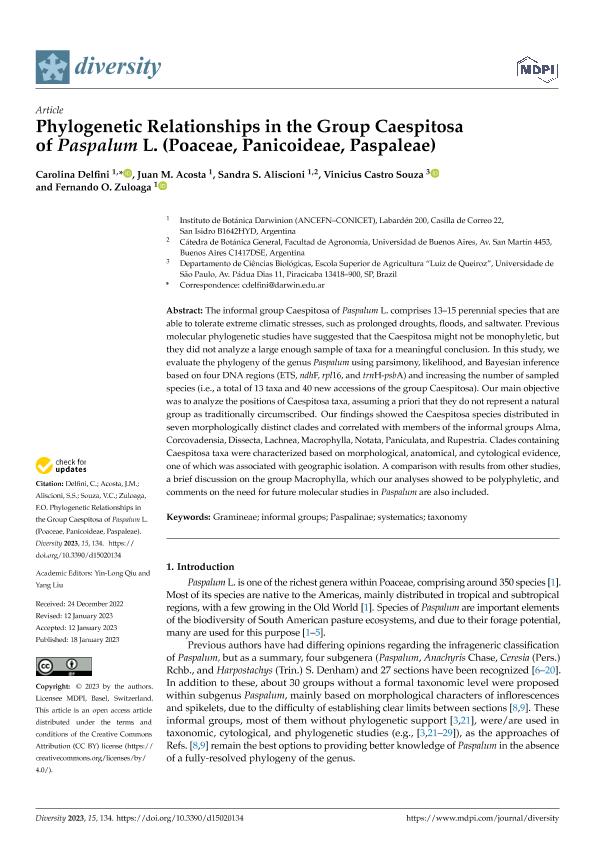Artículo
Phylogenetic Relationships in the Group Caespitosa of Paspalum L. (Poaceae, Panicoideae, Paspaleae)
Delfini Feliciano, Carolina ; Acosta, Juan Manuel
; Acosta, Juan Manuel ; Aliscioni, Sandra Silvina
; Aliscioni, Sandra Silvina ; Castro Souza, Vinicius; Zuloaga, Fernando Omar
; Castro Souza, Vinicius; Zuloaga, Fernando Omar
 ; Acosta, Juan Manuel
; Acosta, Juan Manuel ; Aliscioni, Sandra Silvina
; Aliscioni, Sandra Silvina ; Castro Souza, Vinicius; Zuloaga, Fernando Omar
; Castro Souza, Vinicius; Zuloaga, Fernando Omar
Fecha de publicación:
01/2023
Editorial:
MDPI
Revista:
Diversity
ISSN:
1424-2818
Idioma:
Inglés
Tipo de recurso:
Artículo publicado
Clasificación temática:
Resumen
The informal group Caespitosa of Paspalum L. comprises 13–15 perennial species that are able to tolerate extreme climatic stresses, such as prolonged droughts, floods, and saltwater. Previous molecular phylogenetic studies have suggested that the Caespitosa might not be monophyletic, but they did not analyze a large enough sample of taxa for a meaningful conclusion. In this study, we evaluate the phylogeny of the genus Paspalum using parsimony, likelihood, and Bayesian inference based on four DNA regions (ETS, ndhF, rpl16, and trnH-psbA) and increasing the number of sampled species (i.e., a total of 13 taxa and 40 new accessions of the group Caespitosa). Our main objective was to analyze the positions of Caespitosa taxa, assuming a priori that they do not represent a natural group as traditionally circumscribed. Our findings showed the Caespitosa species distributed in seven morphologically distinct clades and correlated with members of the informal groups Alma, Corcovadensia, Dissecta, Lachnea, Macrophylla, Notata, Paniculata, and Rupestria. Clades containing Caespitosa taxa were characterized based on morphological, anatomical, and cytological evidence, one of which was associated with geographic isolation. A comparison with results from other studies, a brief discussion on the group Macrophylla, which our analyses showed to be polyphyletic, and comments on the need for future molecular studies in Paspalum are also included.
Palabras clave:
GRAMINEAE
,
INFORMAL GROUPS
,
PASPALINAE
,
SYSTEMATICS
,
TAXONOMY
Archivos asociados
Licencia
Identificadores
Colecciones
Articulos(IBODA)
Articulos de INST.DE BOTANICA DARWINION (I)
Articulos de INST.DE BOTANICA DARWINION (I)
Citación
Delfini Feliciano, Carolina; Acosta, Juan Manuel; Aliscioni, Sandra Silvina; Castro Souza, Vinicius; Zuloaga, Fernando Omar; Phylogenetic Relationships in the Group Caespitosa of Paspalum L. (Poaceae, Panicoideae, Paspaleae); MDPI; Diversity; 15; 2; 1-2023; 1-16
Compartir
Altmétricas



